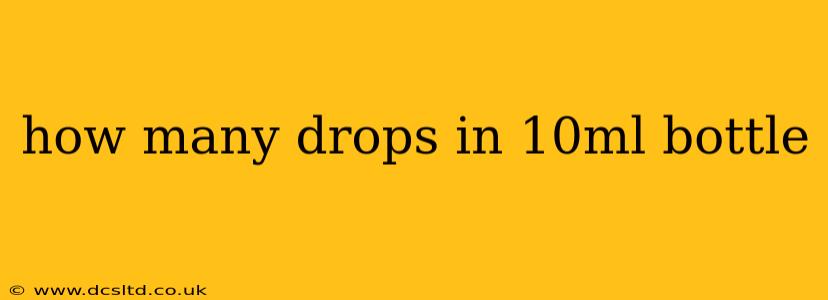How Many Drops Are in a 10ml Bottle? It's Trickier Than You Think!
The seemingly simple question, "How many drops are in a 10ml bottle?" doesn't have a straightforward answer. The number of drops varies significantly depending on several factors, making it impossible to give a single definitive number. Let's explore why.
What Factors Affect the Number of Drops?
Several factors influence how many drops fit into 10ml:
-
The liquid itself: Viscosity (thickness) plays a major role. Thick liquids like honey will produce fewer, larger drops than thin liquids like water or alcohol. Surface tension also affects drop size.
-
The dropper: The size and design of the dropper significantly impact the volume of each drop. A narrow-tipped dropper will dispense smaller drops than a wider one. Even slight variations in dropper manufacturing can lead to differences.
-
Dropping technique: The speed and angle at which you dispense the liquid affect drop size and consistency. A forceful squeeze will produce larger drops than a gentle one.
-
Temperature: Temperature can influence viscosity; a warmer liquid might produce larger drops than a colder one.
So, Can We Give an Estimate?
While we can't give an exact number, we can provide a reasonable range. For water at room temperature using a standard dropper, you might expect anywhere from 200 to 300 drops in a 10ml bottle. However, this is just an approximation. For thicker liquids, expect a significantly lower number of drops. For thinner liquids, the number may be slightly higher.
What About Official Guidelines?
There aren't any official guidelines or standardized measurements for the number of drops per milliliter. This is because the inherent variability mentioned above makes standardization impractical.
How Can I Estimate Drops for My Specific Liquid?
The best way to estimate the number of drops in your 10ml bottle is to perform a simple test:
- Use your specific dropper and liquid: Don't rely on estimates for a different liquid or dropper.
- Count the drops: Carefully dispense drops into a small measuring device (like a graduated cylinder or even a small measuring spoon) until you reach a known volume (e.g., 1ml).
- Calculate: Multiply the number of drops in your test volume by 10 to get an approximate number of drops in 10ml.
This method provides a much more accurate estimate tailored to your specific circumstances.
Why Is This Information Important?
Understanding the variability in drop size is crucial in several applications, including:
- Medicine: Accurate dosing often relies on drop counts, so understanding limitations is vital.
- Science: Experiments requiring precise liquid measurements need to account for the imprecision of drop counting.
- DIY Projects: Many craft or home projects rely on drop-based measurements, and accurate estimations are helpful.
In conclusion, while a precise number of drops in a 10ml bottle is impossible to state definitively, understanding the influencing factors and employing a simple testing method allows for reasonable estimations specific to your liquid and dropper. Always prioritize accuracy when precision matters.
